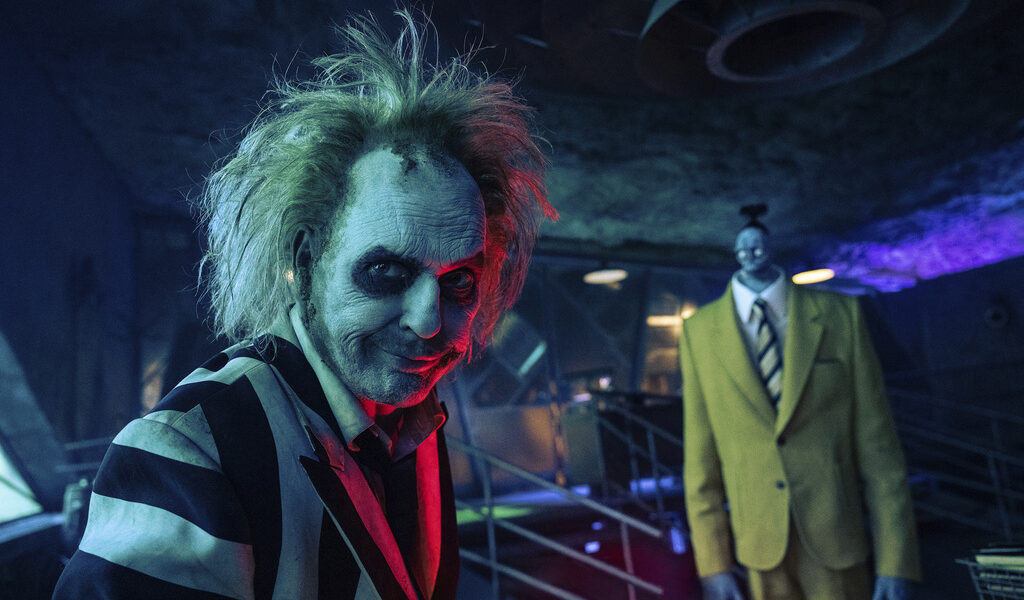Well, after a short 36 years—or two and a half-some new generations later—it’s finally showtime!
The wacky, surreal, peculiar, macabre, strange and unusual world of Tim Burton’s “Beetlejuice” has been resurrected from the underworld once again to haunt and possess the big screen.
Although this modernized continuation is softened in the type of risqué humor that was employed in the revered 1988 original, the 2024 sequel—while objectionably corny at times—is just as absurd. And even with its largely predictable and seemingly unnecessary new characters, “Beetlejuice Beetlejuice” is still a pretty fun watch.
Original “Juice” fans see the return of cast members like Michael Keaton (Beetlejuice), Winona Ryder (Lydia Deetz) and Catherine O’Hara (Delia Deetz), along with Beetlejuice newcomers like rising film star Jenna Ortega (as Lydia’s daughter, Astrid) and character actor favorite Willem Dafoe (as the former movie star turned ghost detective Wolf Jackson), expand upon the familiar and beloved dark goofiness of Burton’s portrayals of life, death and the afterlife.
**Mild spoilers beyond this point**
“Beetlejuice Beetlejuice” starts by dropping us into the present-day life of Lydia, who is capitalizing on her ghost-seeing abilities by hosting and starring in a ghost hunting television talk show. She is codependently involved in a relationship with her producer, Rory (played by Justin Theroux), and has a strained relationship with her daughter, Astrid, all while continuing to be haunted by the horrible memories of Beetlejuice. And to bleakly top it all off, Lydia’s father has just died from a shark attack after his plane crashed in the ocean while off on a bird-watching trip in South America.
The death of her father forces Lydia and her dysfunctional family to return to the Deetz’ family home in Winter River, where relationships and circumstances get even messier, eventually forcing Lydia to enlist Beetlejuice’s help again, which he agrees to do—for the small price of her hand in marriage—so he can get away from his literal demon, soul-sucker of an ex-wife.
Although not without faults, the sequel film can amuse new and old viewers with its quirky characters, gratifying callbacks and decently detailed worldbuilding.
But one of the sequel’s biggest faults lie with a few of the new characters that were supposed to aid in those callbacks and worldbuilding.
Unlike Astrid (Ortega) and Wolf Jackson (Dafoe), who helped to effectively develop the above and under worlds of the the film’s mainstays like Lydia and Beetlejuice, new figures Delores (Beetlejuice’s ex-wife, played by Monica Bellucci), Rory (Theroux) and Jeremy (Astrid’s love interest, played by Arthur Conti) struggle to achieve the same efficacy.
This underwhelming development is most noticeable with Bellucci’s character, who is strongly introduced to the film quite early on, but then grossly underutilized.
The audience first sees Delores as she’s piling her dismantled body parts back together with staples in a Frankenstein-y montage set to the music of the Bee Gees’ “Tragedy.” With such a solid introduction, this viewer really believed she was going to be a key player all through the film.
But that wasn’t the case.
Delores is seen a few times throughout the film, always doing the same thing and repeating the same line: sucking a soul and asking “Where’s Beetlejuice?” in a caricaturesque and breathy Italian accent. And her death towards the end of the film is handled pretty much in the same manner: hastily and insignificantly. Overall, the character of Delores is quickly forgotten.
Bellucci’s character had a lot of potential that was just not used effectively. I mean, she was a literal soul-sucker—the writers could have really made her a much bigger villain. And considering Bellucci’s fairly young romantic relationship with Burton (they began dating just last year), this character fumble left me feeling like Delores’ part was just a nepotism role and largely unnecessary.
What narrowly saves Bellucci’s character from being entirely useless is her connection to the first film. In the 1988 original, Beetlejuice mentions that he was once married and flashes a severed finger with a wedding band on it when trying to force Lydia into marriage. So Delores does cheaply offer the audience some interesting insight into Beetlejuice’s past while calling back to the film’s origins.
Basically, it’s callbacks like these and other moments of nostalgia from the first film that “Beetlejuice Beetlejuice” excels at.
Many elements from the sequel do service to fans of the original: familiar set and character designs with pointed camera pans of iconic locations, classic Burton absurdities and a reappearance and extension of Danny Elfman’s original musical score, even the recognizable color palette and background imagery of the original film are generously included.
In “Beetlejuice Beetlejuice,” saddling the film on the sentimentalities gets a pass. I mean, why else would we want to see a sequel to “Beetlejuice” nearly 40 years later, if not purely for the nostalgia?
Keaton and O’Hara provide the best displays for this nostalgia with the reprisal of their roles. Even three decades later, Keaton and O’Hara are able to pick right back up where they left off in the original.
The audience gets to see some character development through their present-day professions: Delia’s art career continued to grow and she is now a highly successful performance artist, and Beetlejuice’s bio-exorcism business is booming enough to have a sizable team of Bobs working for him in the Afterlife Call Center.
Because they were such representative characters of the first film, it’s enjoyable to see them doing so well. And Keaton and O’Hara skillfully nail their characters right on the little shrunken heads.
Beetlejuice, although a bit more tamed, is still creepy, grubby and obnoxious. And Delia is still madly in-love with herself, her art and her now-dead husband Charles. The two of them steal the show and effortlessly make the sequel worth watching while sipping on whatever overpriced “Beetlejuice” themed cocktail your local movie theater is slinging.
Now, would I recommend the sequel over the 1988 original? Definitely not.
Do I think Beetlejuice really needed this sequel? Again, no.
Would I recommend it to fans of the original? Wholeheartedly, yes. And I will happily watch it again next year when it’s added to my Halloween movie viewing rotation.







